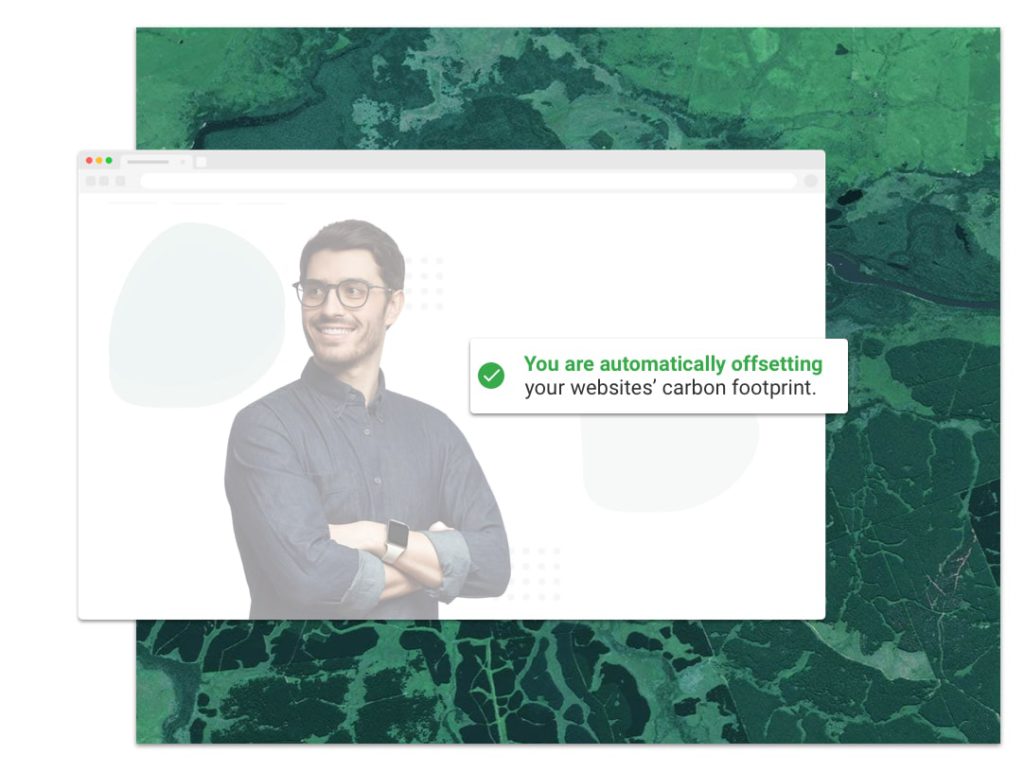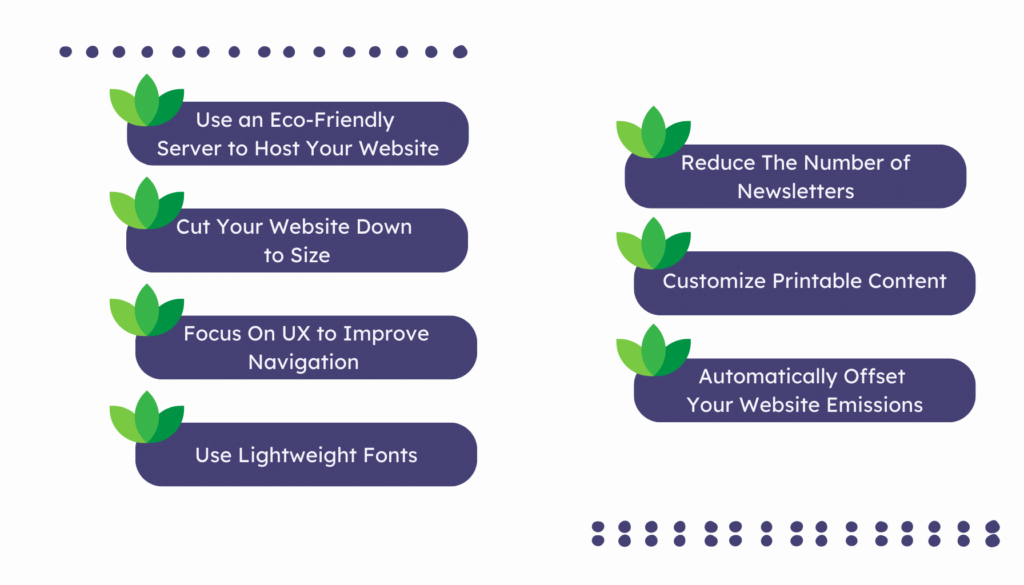
As the world progresses towards a greener future, it’s becoming increasingly important for businesses and individuals to consider the impact of their online activities on the environment. In the same way eco-friendly cars are becoming sought after due to the impending ban on petrol and diesel cars, it is inevitable that eco-friendly websites will be the norm too, in the near future.
Despite the common misconception that digital is a greener alternative to print, every single online activity, from browsing to streaming, has a carbon footprint. This means that websites have a responsibility to reduce their carbon emissions and play their part in mitigating the effects of climate change. In fact, the IT sector is estimated to consume 7% of global electricity.
However, making your website more environmentally friendly doesn’t have to be a costly or complex endeavor. There are simple steps you can take to reduce your website’s carbon footprint and contribute to a sustainable future. So let’s explore some practical tips to help you get started.
Understanding Digital Carbon Footprint
In short, digital carbon footprint refers to the amount of greenhouse gas emissions generated by the use of digital technology, including websites, social media, emails, and other online activities. The carbon footprint of digital activities matters because it contributes to the overall carbon footprint of an individual, business, or organization, ultimately leading to climate change. The digital carbon footprint is calculated by estimating the energy consumption of digital devices, servers, and data centers that power online activities.
Automatically Make Your Website Carbon Neutral
Pathmonk Climate automatically offsets your emissions through high-quality climate projects, while analyzing and calculating your website’s carbon footprint. Showcase your climate actions with your zero-emission website certificate.

During the COVID-19 pandemic, many people around the world shifted to remote work and digital activities spiked significantly. As a result, the carbon emissions from digital activities also increased, seeing global internet usage increase by 30% during the pandemic. This surge in digital activities has partially offset the gains made in reducing emissions from transportation and other sectors.
However, even before the pandemic, the digital carbon footprint was already a growing concern. Digital technologies are responsible for 4% of global greenhouse gas emissions, and this figure is increasing by 9% a year, according to a report by The Shift Project.
In addition, the rise of remote work and digital nomad lifestyles is also increasing the digital carbon footprint. A study by the Carbon Trust found that remote work can lead to a 20% increase in the carbon footprint of office-based employees, as they rely more heavily on digital technologies for communication and collaboration.
To address this issue, many governments and companies are taking steps to reduce the environmental impact of digital activities. For example, the European Union has set a target to become climate-neutral by 2050, and this includes a focus on reducing the carbon footprint of the digital sector. Companies such as Google and Microsoft have also committed to becoming carbon-neutral and are investing in renewable energy and carbon offsets to reduce their emissions.
The Impact of Websites on the Environment
Websites have a significant impact on the environment due to the amount of energy they consume and the associated carbon emissions. The energy consumption of websites is mainly attributed to the servers that host them, which require electricity to run 24/7. Additionally, the devices used to access websites, such as laptops and smartphones, also contribute to the carbon footprint. When users access a website, data is transmitted from the server to their device, requiring energy to power the data centers and network infrastructure.
The energy usage of websites has a tangible impact on the environment, contributing to climate change and other environmental issues. The energy consumed by websites and data centers is primarily derived from non-renewable sources such as coal and natural gas, which emit greenhouse gases when burned. Furthermore, the production and disposal of electronic devices used to access websites also have significant environmental impacts, including e-waste and pollution.
Ways to Make Your Website Environmentally Friendly
Use an Eco-Friendly Server to Host Your Website
When it comes to hosting your website, not all servers are created equal. Some servers are more environmentally friendly than others, and by choosing the right server, you can significantly reduce your website’s carbon footprint.
One way to do this is to choose a hosting provider that uses renewable energy sources to power their servers. Some of the most popular hosting providers, such as Amazon Web Services and Google Cloud Platform, have committed to using renewable energy to power their data centers.
Another option is to choose a hosting provider that uses energy-efficient hardware. For example, some providers use solid-state drives (SSDs) instead of traditional hard drives, which consume less energy.
By choosing an eco-friendly server, you can significantly reduce your website’s carbon footprint and contribute to a more sustainable future.
Cut Your Website Down to Size
One of the biggest contributors to a website’s carbon footprint is the amount of data it requires to load. By reducing the size of your website, you can reduce the amount of data that needs to be transferred, which can significantly reduce your website’s carbon footprint.
One way to do this is to compress your images and other media files. There are many tools available that can help you do this, such as Adobe Photoshop and TinyPNG. You can also use a content delivery network (CDN) to serve your files more efficiently, which can further reduce your website’s carbon footprint.
Simplify your design. By reducing the number of graphics, animations, and other elements on your website, you can significantly reduce the amount of data that needs to be transferred, and therefore reduce your website’s carbon footprint.
Focus On UX to Improve Navigation
Improving the user experience (UX) of your website can not only benefit your visitors but it can also benefit the environment. By improving navigation and ensuring that visitors can find the information they need quickly and easily, you can reduce the number of pages they need to visit, which can reduce your website’s carbon footprint.
One way to improve navigation is to use clear and concise menu items and labels. This can help visitors find what they’re looking for quickly and easily, without having to navigate through multiple pages.
Use internal linking. By linking to related pages and content within your website, you can help visitors find the information they need without them having to navigate to multiple pages.

Use Lightweight Fonts
Fonts play a big role in website design, as each font carries different weights, some requiring more energy to render on the screen than others, which can contribute to your website’s carbon footprint.
By using lightweight fonts, you can reduce the energy required to render text on your website, which can significantly reduce your website’s carbon footprint. Some examples of lightweight fonts include Open Sans, Roboto, and Lato.
Reduce The Number of Newsletters
If your website sends out regular newsletters, you may be contributing to your website’s carbon footprint without even realizing it. Every time you send out a newsletter, it requires energy to transfer the data, and this can add up over time.
By reducing the number of newsletters you send out, you can significantly reduce your website’s carbon footprint. You can also consider using a service like Mailchimp, which uses renewable energy sources to power its servers.
Customize Printable Content
If you offer printable content on your website, such as PDFs or whitepapers, take steps to make them more environmentally friendly. You can do this by customizing the content to reduce the amount of ink and paper required to print it.
You can use software tools to remove unnecessary images, reduce font sizes, and adjust margins to create a more streamlined and eco-friendly document. You can also encourage your audience to read the content online instead of printing it out.
Automatically Offset Your Website Emissions with Pathmonk Climate
One of the easiest and most effective ways to make your website more environmentally friendly is to use Pathmonk Climate. Pathmonk Climate enables you automatically offset your digital carbon footprint with certified green projects.
By using Pathmonk Climate, you can ensure that your website is completely carbon-neutral, without having to make any changes to your website design or functionality. By using Pathmonk Climate, you can show your audience that you are committed to sustainability and reducing your impact on the environment. Additionally, it can be a great marketing tool to attract environmentally-conscious customers to your website.
Conclusion
Websites, although seemingly innocuous, contribute significantly to digital carbon emissions. By implementing the steps outlined in this article, such as using eco-friendly servers, reducing website size, focusing on user experience, using lightweight fonts, and offsetting emissions, we can all make a positive impact on the environment without compromising the functionality of our websites.
Additionally, it’s worth noting that the responsibility of reducing digital carbon emissions isn’t solely on individuals and small businesses; governments and larger corporations also have a role to play in creating a more sustainable future. By working together and taking action, we can ensure that our digital presence doesn’t harm the planet but rather contributes to a healthier, more sustainable future for all.








